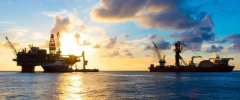For over a decade, the shale patch has been the engine behind U.S. oil production growth. Now, the pattern is shifting to offshore oil amid tech advances and maturing shale reservoirs—with the help of a pro-oil federal government.
Earlier this year, the Energy Information Administration said it expected oil output from Gulf of Mexico fields to rise from 1.8 million barrels daily at the moment to 2.4 million barrels daily as early as 2027. The Bureau of Ocean Energy Management had the same estimate. The two cited federal support in the form of easier permitting, technological advancements that make offshore drilling more economic and efficient, and investment appetite in the industry.
This month, BP said it would go ahead with a $5-billion investment into a new offshore project in the Gulf that would tap reserves of some 350 million barrels of crude. The company said the Tiber-Guadalupe project would add 80,000 barrels daily to its total U.S. output as it eyes boosting this to over 1 million barrels daily.
Yet that was not the only recent offshore oil news from the United States. BP again, in partnership with Chevron, earlier this year also announced a discovery in the Far South prospect, with an executive saying, “This Far South discovery demonstrates that the Gulf of America remains an area of incredible growth and opportunity for bp.” Indeed, the supermajor plans to ramp up its Gulf output to 400,000 barrels daily by 2030.
Related: US Oil Drillers Continue to Back Off As Prices Sink
Also this year, Talos Energy announced a discovery in the Gulf that Wood Makenzie said was the most significant one since Shell’s Whale find in 2017. The Daenerys discovery could produce an estimated 65,000 barrels daily at peak production rates, and it could lead to more discoveries in the area, Wood Mac analysts said in a September report.
“We believe that offshore production will play an increasingly larger role in filling the global energy demand,” Talos Energy’s chief executive, Paul Goodfellow, said in June, as quoted by Reuters. “Questions are starting to arise about the continued long-term economic viability of onshore basins… At the same time, technological advancements have unlocked significant deepwater reserves.”
This is a pretty succinct description of the situation in U.S. oil. For years, shale was a favourite because production could start so much faster than it would at a conventional offshore field. The latter required years of work and a lot of upfront investment, while





